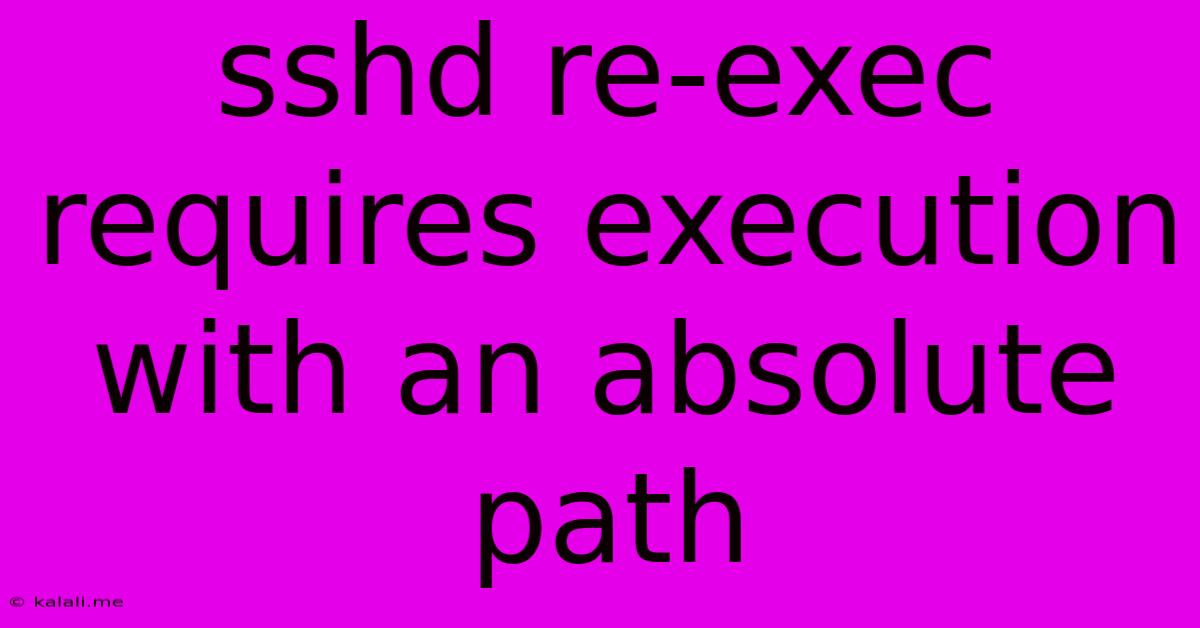Sshd Re Exec Requires Execution With An Absolute Path
Kalali
May 26, 2025 · 3 min read

Table of Contents
SSHD "re-exec requires execution with an absolute path" Error: Troubleshooting and Solutions
The error message "sshd: re-exec requires execution with an absolute path" in SSH (Secure Shell) usually indicates a problem with the path specified for a command or script executed after an SSH connection. This guide will break down the cause of this error and provide effective solutions. Understanding this issue is crucial for maintaining secure and functional SSH servers.
This error primarily occurs when you're attempting to execute a command or script via SSH using a relative path instead of an absolute path. This can stem from incorrect configuration files or a misunderstanding of how SSH handles path resolution. We'll explore various scenarios and solutions to rectify this.
Understanding the Problem: Relative vs. Absolute Paths
Before diving into solutions, let's clarify the difference:
- Absolute Path: A complete path to a file or directory starting from the root directory (
/). Example:/usr/local/bin/my_script.sh. - Relative Path: A path relative to the current working directory. Example:
./my_script.shor../my_script.sh.
The SSH daemon (sshd) requires absolute paths for security reasons. Using relative paths introduces vulnerabilities as the current working directory can vary depending on the user's login environment, potentially leading to unintended script execution.
Common Scenarios and Solutions
Here are several scenarios where this error might occur and the corresponding solutions:
1. Incorrect Path in SSH Configuration Files (~/.ssh/config or /etc/ssh/sshd_config)
If you're using Match blocks in your SSH configuration files to specify commands to execute upon connection, ensure that any paths specified are absolute. For instance, if you're using a Match block to run a script:
Match User user1
Exec /usr/local/bin/my_script.sh
Verify that /usr/local/bin/my_script.sh is the correct absolute path to your script. Incorrect paths, especially relative ones, will trigger the error.
2. Incorrect Shebang in Scripts
The shebang (the first line of a script, e.g., #!/bin/bash) specifies the interpreter. If your script uses a relative path in the shebang (e.g., #!/usr/bin/env bash), it might cause issues depending on the user's environment. Using an absolute path in the shebang is always best practice:
#!/bin/bash
# ... rest of your script ...
3. Incorrect Path in Startup Scripts or other automated processes
If the error is encountered during a server startup process or other automated tasks that involve SSH, double-check all paths specified in those scripts or configuration files. Ensure that all executable paths are absolute.
4. Permissions Issues
Ensure the script or executable has the correct permissions to be executed. Use the chmod command to set appropriate execute permissions:
chmod +x /usr/local/bin/my_script.sh
5. Incorrectly configured environment variables
If your script relies on environment variables, make sure these variables are set correctly before the script is executed, and that the paths defined within these variables are absolute.
Best Practices for Preventing Future Errors
- Always use absolute paths: This is the most important preventative measure. It eliminates ambiguity and enhances security.
- Test thoroughly: After making any changes to your SSH configuration or scripts, test them thoroughly to ensure they function as expected.
- Regularly review your configuration files: Periodically review your SSH configuration files to identify and rectify potential issues before they cause problems.
- Use a version control system: Track changes to your scripts and configuration files using a version control system like Git to easily revert to previous versions if necessary.
By carefully reviewing and correcting path specifications, ensuring proper permissions, and adhering to these best practices, you can effectively resolve the "sshd: re-exec requires execution with an absolute path" error and maintain a secure and reliable SSH server. Remember, security is paramount; always prioritize absolute paths in your SSH configurations.
Latest Posts
Latest Posts
-
Imagery Or Figurative Language From Romeo And Juliet
Jul 02, 2025
-
What Is A Quarter Of A Million
Jul 02, 2025
-
Which Of The Following Is True Concerning A Dao
Jul 02, 2025
-
How Long Can Catfish Live Out Of Water
Jul 02, 2025
-
Is Kanye West Related To Cornel West
Jul 02, 2025
Related Post
Thank you for visiting our website which covers about Sshd Re Exec Requires Execution With An Absolute Path . We hope the information provided has been useful to you. Feel free to contact us if you have any questions or need further assistance. See you next time and don't miss to bookmark.